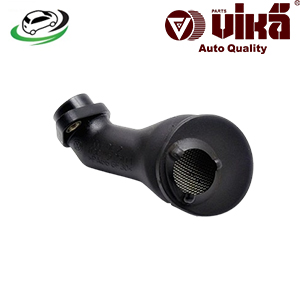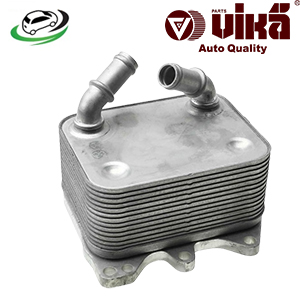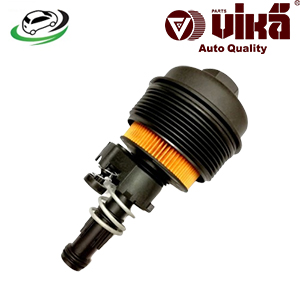Get Oil Filter Housing VW Polo/Passat/Bora/Sagitar / AUDI A3/ vehicles with 1.6 and 1.4 TSI engines 03C115433B
The oil filter housing is a crucial component in an internal combustion engine’s lubrication system. It serves as the enclosure for the oil filter, holding it in place and connecting it to the engine’s oil passages. The oil filter housing ensures that the engine oil passes through the filter to remove contaminants before circulating back into the engine. This filtration process is vital for maintaining engine performance, longevity, and efficiency.
1. Design and Structure
The oil filter housing is typically made of durable materials such as aluminum, steel, or plastic, depending on the vehicle’s make and model. The design of the housing varies, but it generally consists of the following key elements:
- Mounting Base: The base of the housing is securely bolted to the engine block. It contains the ports through which oil enters and exits the filter.
- Sealing Surface: The housing includes a sealing surface that interfaces with the oil filter or a replaceable gasket. This ensures a tight seal, preventing oil leaks and maintaining proper oil pressure.
- Internal Channels: Inside the housing, there are channels that direct oil flow into and out of the filter. These channels are designed to optimize the flow and ensure that all the oil passing through the engine is adequately filtered.
- Bypass Valve (Optional): Some oil filter housings include a bypass valve that allows oil to bypass the filter if it becomes clogged. This is a safety feature that ensures the engine continues to receive oil, even if unfiltered, to prevent catastrophic engine damage.
- Oil Cooler Integration (Optional): In some designs, the oil filter housing is integrated with an oil cooler. This setup helps regulate the temperature of the engine oil, ensuring it remains within optimal operating parameters.
2. Functionality
The primary function of the oil filter housing is to securely hold the oil filter and facilitate the flow of oil through the filter. The housing ensures that the oil is cleaned of contaminants like metal shavings, dirt, and carbon deposits before it recirculates through the engine. This filtration process is critical for preventing wear and tear on engine components, improving engine efficiency, and extending the overall life of the engine.
How the Oil Filter Housing Works:
- Oil Enters the Housing: Engine oil is pumped into the oil filter housing from the engine’s oil pump. The housing directs the oil into the filter element.
- Filtration Process: Inside the filter, oil passes through a filter medium that captures contaminants. Clean oil then exits the filter and flows back into the housing.
- Oil Returns to Engine: The cleaned oil is directed back into the engine’s lubrication system, where it continues to lubricate, cool, and protect engine components.
- Bypass Valve Operation: If the filter becomes clogged or if the oil is too thick (for example, during cold starts), the bypass valve (if present) will open to allow unfiltered oil to bypass the filter. This ensures that oil continues to flow to the engine, preventing oil starvation.
3. Materials and Manufacturing
The oil filter housing is designed to withstand the harsh conditions of the engine environment, including high temperatures, pressure, and exposure to chemicals.
- Aluminum: Many oil filter housings are made from aluminum due to its lightweight nature and excellent heat dissipation properties. Aluminum is also resistant to corrosion, making it ideal for use in the engine bay.
- Steel: In some vehicles, particularly older models or heavy-duty engines, steel housings are used. Steel is extremely durable and can withstand high pressures and impacts, although it is heavier than aluminum.
- Plastic: Modern vehicles increasingly use high-strength plastic for oil filter housings. Plastic is lightweight, cost-effective, and can be molded into complex shapes, making it suitable for integrating additional features like oil coolers. However, plastic housings can be more susceptible to cracking under extreme conditions.
The manufacturing process typically involves precision casting or molding, followed by machining to ensure that the housing meets strict tolerances and can securely hold the oil filter without leaks or failures.
4. Importance in Engine Operation
The oil filter housing plays a critical role in ensuring that the engine receives clean oil, which is essential for:
- Engine Protection: By ensuring that all engine oil is filtered, the housing helps protect internal engine components from damage caused by contaminants. This reduces wear on parts like the crankshaft, camshaft, and bearings.
- Maintaining Oil Pressure: The housing helps maintain the proper oil pressure within the engine. A well-sealed housing prevents oil leaks, which could otherwise lead to a drop in oil pressure and subsequent engine damage.
- Oil Temperature Regulation: In designs where the housing is integrated with an oil cooler, it also helps regulate the oil temperature. Keeping the oil within its optimal temperature range improves lubrication efficiency and prevents overheating.
5. Common Issues and Maintenance
Over time, the oil filter housing can develop issues, particularly if it’s not properly maintained or if the vehicle operates in extreme conditions.
- Oil Leaks: One of the most common issues with oil filter housings is oil leaks. These can occur due to a worn or damaged gasket, a cracked housing, or improper installation of the filter. Leaks can lead to a drop in oil levels, reducing lubrication and potentially causing engine damage.
- Clogged Bypass Valve: If the housing includes a bypass valve, it can become clogged or fail, preventing it from opening when needed. This can cause the oil filter to become clogged, leading to oil starvation.
- Cracked Housing: Plastic oil filter housings, in particular, can develop cracks over time, especially if exposed to extreme temperatures or if over-tightened during installation. A cracked housing can lead to significant oil leaks and must be replaced immediately.
- Corrosion: In steel housings, corrosion can occur, especially in vehicles operated in harsh environments or those that aren’t driven regularly. Corrosion weakens the housing, making it more prone to leaks or failure.
Maintenance Tips:
- Regular Oil Changes: Regular oil changes are essential for maintaining the oil filter housing’s integrity. Fresh oil helps prevent sludge buildup, which can clog the filter and bypass valve.
- Inspect for Leaks: Periodically inspect the oil filter housing for signs of leaks, especially after an oil change. Check around the sealing surface and mounting points for any oil residue or drips.
- Replace Gaskets: During oil changes, it’s important to replace the oil filter gasket (or O-ring) to ensure a proper seal. Over time, gaskets can become brittle and fail, leading to leaks.
- Avoid Over-tightening: When installing a new oil filter, avoid over-tightening it, as this can damage the gasket or even crack the housing. Follow the manufacturer’s torque specifications for proper installation.
6. Replacement and Repair
If the oil filter housing becomes damaged, it typically needs to be replaced rather than repaired. Replacement involves the following steps:
- Drain the Oil: The engine oil must be drained before removing the housing to prevent spillage and to ensure a clean installation process.
- Remove the Old Housing: The damaged housing is unbolted from the engine block. This may require removing other components for access, depending on the vehicle’s design.
- Inspect and Clean: Before installing the new housing, inspect the mounting surface for any damage or debris. Clean the area to ensure a proper seal.
- Install the New Housing: The new housing is bolted in place, ensuring that it’s properly aligned and torqued to the manufacturer’s specifications. The oil filter and gasket are then installed.
- Refill with Oil: After installation, the engine oil is refilled, and the vehicle is started to check for leaks and proper oil pressure.
7. Performance and Aftermarket Options
For performance-oriented vehicles or those used in extreme conditions, aftermarket oil filter housings are available that offer enhanced features:
- Improved Cooling: Some aftermarket housings are designed with better-integrated oil coolers, offering enhanced oil temperature regulation for high-performance engines.
- Stronger Materials: Upgraded housings made from reinforced aluminum or billet steel offer improved durability and resistance to cracking or corrosion.
- Enhanced Filtration: Some aftermarket housings are designed to accommodate larger or more efficient oil filters, providing better filtration and engine protection.
Follow us on Facebook for more parts.



